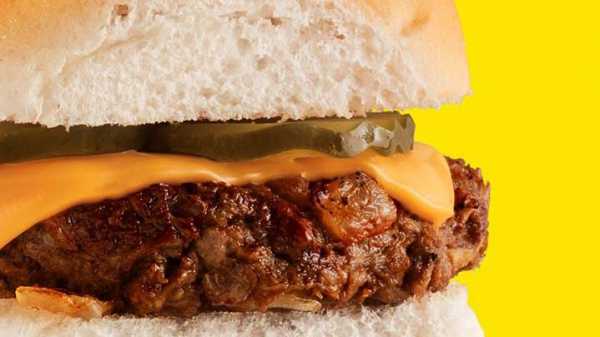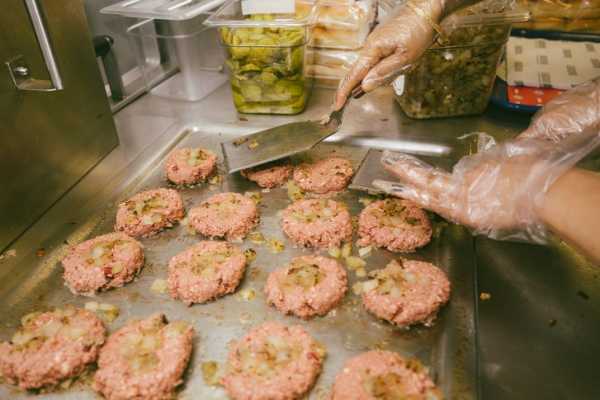
At 8 PM on Wednesday at the White castle in Bushwick, Brooklyn, in the shadow of the elevated L-train tracks , was closed for a private party. Eric Wareheim, of Comedy Duo Tim and Eric show, Aziz Ansari “the master,” played host, greeting guests at the door, dressed in a sharp blue suit with a crisp white shirt, louchely unbuttoned on his chest. Questlove, his signature pick up hidden in his Afro, was spinning records, while the promised performances by Ghostface Killah. Chef Danny Bowien, mission of China, wandered around looking amused.
Cause for celebration was the launch of a new White castle menu item: sliders made by impossible foods, the Silicon valley startup was founded by a Stanford biochemist who developed one hundred percent plant-based hamburger substitute that mimics the molecular composition of beef, even approximating a real Burger “bleeds”. (Ingredients include wheat, coconut oil, potato protein, and soy.) Servers hired specifically for the event was circulated trays of pale, crinkle-cut French fries, fast-cooling onion rings and sliders wrapped in wax paper and cut little paper flags with the words “impossible”, as if everyone was conquered by a miniature Neil Armstrong.
White castle is not the first restaurant offer one of the burgers—you can find them in more than a thousand stores in the U.S., including like Burger restaurant bareburger, and Wahlburger—but this is the first major chain of fast food restaurants to serve them, and in some ways the least likely to pioneer. Based in Wichita, Kansas in 1921, White castle is often credited as the first fast food, and burgers—a small, square shape, ultra-simple, and was sold for eighty-one cents $6.99 for a bag of ten, or $19.99 for the “crave case” of thirty—are iconic. The brand boasts a solid cult (increases significantly, without a doubt, in the 2004 Stoner Comedy “Harold and Kumar go to White castle”), and pre-assembled, frozen sliders are sold almost everywhere frozen food. But White castle feels kind of forgot for a while, and he was not previously interested, to reinvent itself with progressive tricks, like “healthy choice” options—although it offers the usual veggie Burger, “is full of carrots, zucchini, peas, broccoli, spinach, and more!” (Kim Bartley, Director of marketing for White castle, told Forbes that the partnership with the “impossible” is “another way we can satisfy the growing hunger more clients on plant-based proteins.”)
When I first tried the impossible Burger, a few years ago, niche Momofuku, David Chang Italian-Korean restaurant in Chelsea, I was impressed, if not quite defeated. He looked like the Burger until medium-rare pink interior, and smelled the Burger, and even almost taste like a hamburger, at least in texture. But at an upscale restaurant like Chang—where a beef Patty, of course, were made of mineral, clean taste, grass fed, freshly ground local meat—it is impossible Burger felt a little hollow, missing its essence burgery. White castle slider, though—which debuted Thursday at a hundred and forty places in new York, new Jersey and Illinois—was surprisingly nice. Everything was in yellow rubber piece that was allegedly smoked cheddar, and sandwiched with a squirt of ketchup, cooked onions and a few pickle coins signature services on a soft white bun. In contrast to its meat equivalent, it was round, not square, relatively hefty and slightly crumbly in the form of rather loosely Packed Patty. The edges were crunchy and caramelized. Unlike niche version, it was in true fast-food-hamburger form, well done, although I made a bare hint of pink in the center. The taste was vaguely of mushrooms, but basically just salt and fat.

In contrast to its meat equivalent, the impossible Burger is round and not square, relatively hefty and slightly crumbly in the form of rather loosely Packed Patty.
Photo of Noah Devereaux / care for Chan
Tray regular sliders materialized, and I grabbed one of them. Beef, by contrast, was as compressed as a piece of Bologna or shaved a piece of meatloaf, and gray as the sidewalk is prohibited—it does not mean that it doesn’t taste good. He did, especially after half of the Tiki cocktail, decorated with edible flowers in a White castle paper Cup with soda. He gave me this ring satisfaction that seared animal fat usually does. But if I were given a choice of a hamburger, made with cheap beef probably, inhuman, raised, of course, bad for the environment—or vegetable alternative, tried that close to the real thing, I would never have a Burger.
About nine-thirty, Wareheim grabbed the microphone to sing “White castle” and impossible leaders of food products. David Lee, it is impossible for S. F. O. and C. A. A., said to the crowd: “every hamburger eaten, unlike a hamburger, the cow saves the world ninety-five per cent of the land”—someone screamed, their statement—“seventy-five percent of water”is the more louder the squeal— “and produces eighth, one-eighth, of greenhouse gases.” This is the last room called “fuck Yes” and then an ear-curdling scream. “So you can have a delicious Burger without the cholesterol, and have a great time”. As Vladimir began his set, middle-aged man wearing a monogrammed White castle chef whites—he was Philip Bach, “White castle” head corporate chef and Director of innovative products—looked out from the kitchen and served willingly with rapper a request for a call-and-response: “when I say ‘we,’ you say ‘pull!’ Woo!” “Tang!” “Woo!” “Tang!”
The next day, at lunchtime, I took the path train in Jersey city, at another White castle, among the group of Indian restaurants and food stores near the square log to see implementation in action. I was expecting some fanfare: free samples, perhaps, or, at least, a large banner or sign. But looking through the menu over a glassed-in counter, I was troubled: the slider is not even listed. I walked up to the counter. “Do you really want a Burger?” I asked. “Oh, Yes,” she said, and handed me a few flyers. I asked if many people were to order it, and she nodded, unconvincingly. After overhearing us, a middle-aged woman, pausing at the window pickup intervened, “I got it!”
“I read about it when he was in the lab,” the woman, whose name was Fran, told me by taking it impossible for the slider from the paper sleeve and pointing to it as she spoke. She lived in another part of new Jersey, but was in the area to the orthopedist for an appointment and came in White castle as a nostalgic treat, she ate on a chain since she was a child, she told me when the beef slider was worth twelve cents. She had assumed that the impossible Burger is expensive and hard to find, and was surprised and delighted to find White castle, and for only $1.99. “I don’t like to eat a lot of beef,” she said. “I’m organic food, as much as I can afford it”. She took a bite of the slider. “It’s good. This is Mushi. Veggie burgers, they are usually a little firmer than that, but it’s very tasty.” She took a few more bites. “This is delicious”, she decided.
After Fran left, an orthopedic specialist, I sat and watched the lunch crowd ebbs and flows. The Builder ordered the “sixteen burgers without onions, six without cheese”. Women dressed in a hairnet and blue apron hat chose for chicken sliders. No one has mentioned the impossible slider. Then a large man with a gray ponytail jumped to the counter and studied the menu. “I haven’t been here in so long I forgot what you have!” he said. The cashier saw the opening: “we cannot Burger if you want to try something new!” “What?” – the man asked. “The impossible Burger!” the cashier said without any further explanation. “It is impossible Burger!” the man said, laughing. “I’ll tell you what I’m going to stick with what I know.” He ordered a combo, Annex 1: French fries, soft drink, and four original beef sliders.
Sourse: newyorker.com






